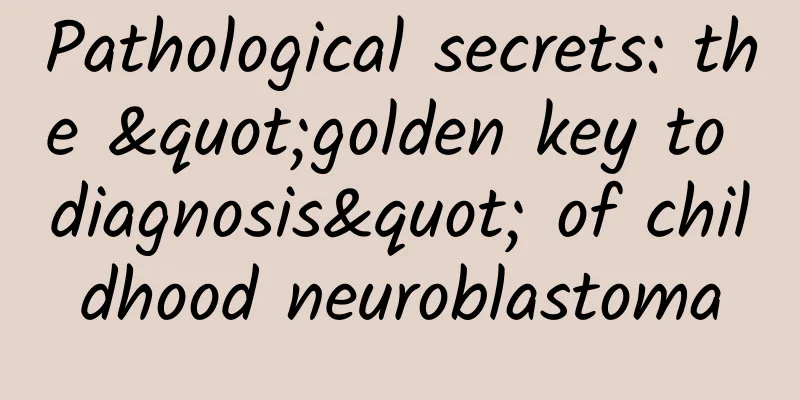Pathological secrets: the "golden key to diagnosis" of childhood neuroblastoma

|
Author: Zou Jizhen, Chief Physician, Children's Hospital, Capital Institute of Pediatrics Reviewer: Meihua Park, Chief Physician, Peking University Third Hospital Childhood neuroblastoma is a common malignant tumor in infants and young children, especially in children under 5 years old. Its diagnosis and treatment process is complex and critical. Pathological examination, as an important basis for diagnosis and treatment guidance, plays an indispensable role in the diagnosis, staging and prognosis assessment of the disease. 1. Timing and methods of pathological examination The pathological examination of childhood neuroblastoma usually flexibly selects the timing and method according to the specific situation of the child. When the tumor is huge and not suitable for immediate surgery, fine needle aspiration biopsy becomes the first choice. This method uses ultrasound or CT guidance to puncture and sample the tumor. Although the sample size is small, it is sufficient to provide basic diagnostic information. However, due to the limited sample size, fine needle aspiration biopsy has certain limitations in tissue typing and comprehensive evaluation. Therefore, in order to determine the clinical pathological stage and determine whether there is bone marrow metastasis, a bone marrow puncture biopsy is also required. If tumor cells are found in the bone marrow, it indicates that the disease may be in a later stage, which will affect the choice of treatment options, including drug dosage and course of treatment. Figure 1 Original copyright image, no permission to reprint For children who can undergo surgery directly, the pathological examination after radical tumor resection is more comprehensive and accurate. The entire specimen can be used for tissue typing, immunohistochemical staining, and molecular pathological diagnosis, providing a solid basis for the formulation of treatment plans and prognosis assessment. Some children may need chemotherapy to shrink the tumor before surgery because the tumor is too large or there is a high risk. Although the specimen obtained in this case is not as ideal as the specimen obtained by direct radical resection, it can still be used for further pathological diagnosis. 2. Key Steps and Significance of Pathological Examination The pathological examination of childhood neuroblastoma includes three major steps: histopathological examination, immunohistochemical examination and molecular pathological examination, each of which has unique significance. Histopathological examination aims to clarify the tissue type of the tumor, including neuroblastoma, ganglioneuroblastoma (nodular type, mixed type) and ganglioneuroma, etc. This step is crucial for formulating treatment plans and assessing prognosis, because tumors of different tissue types differ in biological behavior and treatment effects. Figure 2 Original copyright image, no permission to reprint Immunohistochemistry tests can identify the tissue origin, benign or malignant nature, and cell proliferation of tumors by detecting the expression of specific antigens. For example, the Ki-67 positivity rate is a cell nuclear proliferation index, which directly reflects the proliferation activity of the tumor and is one of the important indicators for evaluating prognosis. MKI (nuclear fragmentation index) is another important indicator for evaluating the malignancy of tumors by counting the number of nuclear division cells in tumor cells. Molecular pathology examination goes further to the gene level to detect molecular markers related to prognosis, such as N-MYC gene amplification, chromosome 1p36 and 11q deletion, etc. These molecular pathological changes are of great significance for accurately judging prognosis and guiding targeted therapy. In particular, the amplification of the N-MYC gene is considered a strong indication of poor prognosis. 3. Interpretation of key information in pathology reports The pathology report of childhood neuroblastoma is an important basis for comprehensive assessment of disease status, formulation of treatment plan and prognosis. When interpreting the pathology report, the following aspects should be focused on: 1. Lesion site: The site of tumor occurrence is closely related to prognosis. Neuroblastoma originating from the adrenal medulla has a relatively poor prognosis, while tumors originating from the sympathetic chain have a relatively good prognosis. 2. Histological subtype: Different histological subtypes have different effects on prognosis. For example, undifferentiated neuroblastoma usually has a poor prognosis, while mixed ganglioneuroblastoma may have a better prognosis. 3. Immunohistochemistry indicators: The Ki-67 positivity rate and MKI and other indicators directly reflect the proliferation activity of the tumor and are an important reference for evaluating prognosis. 4. Molecular pathological results: Molecular pathological changes such as amplification of the N-MYC gene and deletion of chromosomes 1p36 and 11q are independent predictors of poor prognosis. 5. Tumor capsule and vascular conditions: The integrity of the tumor capsule, the presence of tumor thrombi in the vascular vessels, and lymph node metastasis all have an important impact on prognosis. Tumors with intact capsules, no vascular tumor thrombi, and no lymph node metastasis have a relatively good prognosis. In addition, the pathology report should also pay attention to the age of onset. Generally speaking, children under two years old, especially those under 18 months old, have a relatively good prognosis, which may be related to factors such as the infant's immune system has not yet fully matured and is sensitive to chemotherapy drugs. |
>>: Neuroblastoma: stages, types and prognosis
Recommend
Parents' experience in educating their children Why do some parents like to use spanking to educate their children?
Love without reason can only harm children. The p...
Early identification, standardized diagnosis and treatment of ADHD in children
1. What is Attention Deficit Hyperactivity Disord...
The farts of pregnant women are very smelly during the confinement period
Some women will find that they have smelly farts ...
What should I do if I have frequent and urgent urination during pregnancy?
Pregnant women will encounter some very embarrass...
My period is 7 days late.
Women's menstrual period is generally relativ...
How to get pregnant with polycystic ovary_How to get pregnant with polycystic ovary amenorrhea
I believe that many female friends have heard in ...
Can I do an ultrasound when I am one month pregnant?
B-ultrasound examination is an important new item...
Which leather shoes are better, cowhide or cowhide? Why is cowhide more expensive than cowhide?
Cowhide and cow leather are two different materia...
How to treat gynecological cysts
Gynecology is definitely a hospital outpatient de...
What to do if a woman has severe uterine prolapse
Gynecological diseases are a type of disease with...
How long after the medication abortion can you be sure that the abortion is complete?
Compared with traditional cesarean section, more ...
How to eat glutinous rice balls during the Lantern Festival without becoming "round"? This anti-obesity strategy will make you sweet but not "greasy"
How to eat glutinous rice balls during Yuanxiao s...
An unsolved mystery: constipation, where in the body is blocked?
Defecation is people A "physiological event&...
What to do if the vulva itches after using the suppository
Women need to take care of themselves in many asp...
What are the symptoms of polycystic ovarian syndrome?
Polycystic ovary syndrome is a common disease amo...









